Are you trying to find a tree to beautify and enhance your yard? If so, you should plant a ‘Bloodgood’ Japanese maple. The Bloodgood Japanese maple is a fantastic pick for either a focal point or a tree that adds flair to your landscape due to its magnificent color.
There is also the Emperor Japanese maple, though. This exclusive variety features dark burgundy leaves that gradually turn a fiery, scarlet color. For gardeners who reside in climates that experience significant seasonal variation, the Emperor Japanese maple is said to be the best choice.
Which of these maple trees should you pick, considering they’re both incredibly stunning? It all boils down to individual taste. In this article, we’ll examine the main distinctions and traits between the Bloodgood Japanese maple and Emperor Japanese maple.
Comparing Bloodgood Japanese Maple vs. Emperor Japanese Maple
| Bloodgood Japanese Maple | Emperor Japanese Maple | |
|---|---|---|
| Classification | Acer palmatum ‘Bloodgood’ | Acer palmatum ‘Wolff’ |
| Alternative Names | Blood Japanese maple | Emperor 1, Red Emperor |
| Origin | Japan | Japan |
| Description | A variety of Japanese maple with a very thin trunk and bright burgundy-red leaves | A variety of Japanese maple that boasts deep, burgundy leaves that turn fire-red in the fall |
| Uses | Ornamental, also used in traditional medicine | Ornamental, also used in traditional medicine |
| Growth Tips | Always protect saplings from strong winds and plant in well-drained soil | Protect sapling from frosts and plant in dappled shade |
| Interesting Features | Can reach up to 20 feet tall and retains its color throughout all seasons | This variety is quite heat-tolerant and will rarely scorch |
The Key Differences Between Bloodgood Japanese Maple and Emperor Japanese Maple
It’s worth noting that the Bloodgood Japanese maple and Emperor Japanese maple are both the same tree, just different cultivars. However, their differences go beyond classification.
To start, the Bloodgood Japanese maple is much more common among nurseries in the United States. The Emperor Japanese maple is a lot rarer, but not impossible to find as saplings.
Bloodgood Japanese maples are also larger than their Emperor cousins. Bloodgoods can easily reach 20 feet tall, with some rare specimens reaching 25 feet tall. The Emperor Japanese maple doesn’t usually get much larger than 20 feet. However, the Emperor Japanese maple grows slightly faster than the Bloodgood.
There’s also weather tolerance. Emperor Japanese maples can handle heat and cold much better than the Bloodgood variety. The Emperor variety also tends to boast a more vibrant, fiery red color in its leaves for a longer period of time than the Bloodgood.
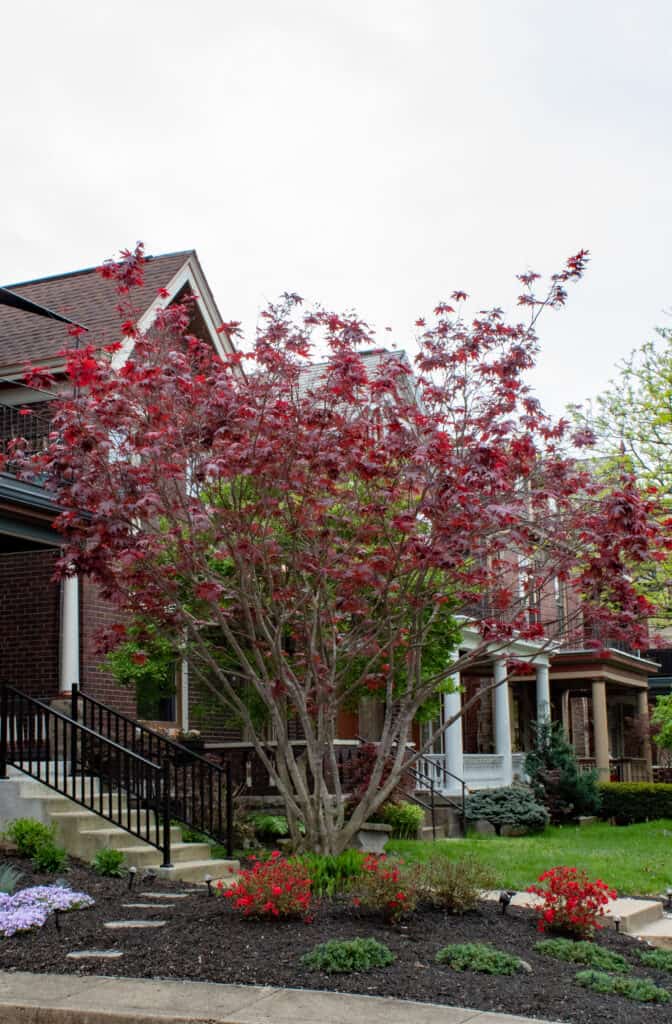
The Emperor Japanese maple is smaller than the Bloodgood variety usually remaining below 20 feet.
©Rosamar/Shutterstock.com
Bloodgood Japanese Maple vs. Emperor Japanese Maple: Classification
The Bloodgood Japanese maple and Emperor Japanese maple are both technically the same tree. They are different cultivars of the Acer palmatum, or Japanese maple. The Japanese maple is a short tree in the Sapindaceae family. The Bloodgood Japanese maple is classified as Acer palmatum ‘Bloodgood’ while the Emperor Japanese maple is classified as Acer palmatum ‘Wolff’.
Bloodgood Japanese Maple vs. Emperor Japanese Maple: Description
The Bloodgood Japanese maple is a common variety of the Japanese maple grown in the United States. The Bloodgood Japanese maple has a trunk that is only the size and shape of a drinking cup and mature trees can grow to be between 15 and 20 feet tall. The Bloodgood Japanese maple’s capacity to maintain its color throughout the season is one of its most alluring qualities. In the spring and into the summer, a rich burgundy color occurs. Autumn’s cool months saw a vibrant red take over. A Bloodgood Japanese maple’s silvery bark attracts attention on its own.
An upgraded form of upright Japanese maple that resembles the traditional Bloodgood is the Emperor variety. The Emperor, a miniature shade tree, has three distinct seasons of intense red to purple color. In the spring and summer, the appealing leaves are a rich shade of burgundy plum. The Emperor Japanese maple’s vivid, blazing crimson leaves are energized by cool weather. Under a variety of circumstances, this cultivar shows remarkable color retention.

The Bloodgood Japanese maple’s capacity to maintain its color throughout the season is one of its most alluring qualities.
©iStock.com/Nahhan
Bloodgood Japanese Maple vs. Emperor Japanese Maple: Uses
The majority of uses for Japanese maples are as landscaping or aesthetic trees. An extremely adaptable plant, the Japanese maple and all of its cultivars can be used as miniature specimens for lawns, an accent plant, a patio tree, a container plant, or as part of a shrub border. Additionally, Japanese maples make fantastic bonsai plants.
This tree has also been used in traditional medicine. The Japanese maple’s bark, leaves, and twigs have been used since at least the 1700s, typically to cure eye ailments and enhance liver function, in addition to its extensive history of usage in traditional medicine. However, the therapeutic properties of the Japanese maple are not supported by scientific research.
Bloodgood Japanese Maple vs. Emperor Japanese Maple: Origin
All Japanese maples are native to Japan. Before World War II, the Bloodgood Japanese maple was introduced to the United States. It is a cultivar that bears the name of the Long Island, New York-based Bloodgood Nursery, where it was created. Dick Wolff at Red Maple Nursery in Pennsylvania first introduced the Emperor Japanese maple in 1976 under the name “Emperor 1,” and a grower in Oregon is believed to have later filed for a patent under that name.
Bloodgood Japanese Maple vs. Emperor Japanese Maple: How to Grow
Bloodgood Japanese maples can tolerate a variety of soil types and like partial sun. USDA Zones 5 through 9 are suitable for growing Bloodgood Japanese maples. These lovely trees require little upkeep and are resistant to disease and pests. If winter pruning is necessary, remove any branches that are crossing. A Japanese maple should not be sheared; you want to preserve it appearing natural. In the spring, fertilize with a premium slow-release fertilizer. Dig a hole twice as wide as the root ball, twice as deep, and fill it halfway with soil.
You may plant your maple almost any time of year as long as you stay away from freezing and extremely hot temperatures. A Bloodgood can be expected to grow one to two feet per year, reaching a mature height of 15 to 20 feet. In order to prevent canopies from crowding one another, if you are growing more than one Bloodgood, space them at least 15 feet apart. There are no concerns about structural damage because the root system of this tree is not known to be invasive.
Emperor Japanese maples thrive in milder climates where late spring frost frequently kills or damages delicate, young leaves. This Japanese maple really gets a head start on other types because it emerges from dormancy a few weeks later. The Emperor can withstand high temperatures and hardly ever gets sunburned, even in direct sunlight. Emperor Japanese maples respond to a variety of moist soil types and do well in both partial shade and full sun. USDA Zones 5 through 9 are suitable for growing these Japanese maples.
The Emperor variety grows two feet annually until it reaches a mature height of 10 to 15 feet, which is a quick growth rate. Dig a hole three times the width of the root ball and plant the tree in the spring or fall, just above the soil line. Add three inches of mulch on top, backfill with soil and slow-release fertilizer, and finish. Always give your maple a good soak after planting.
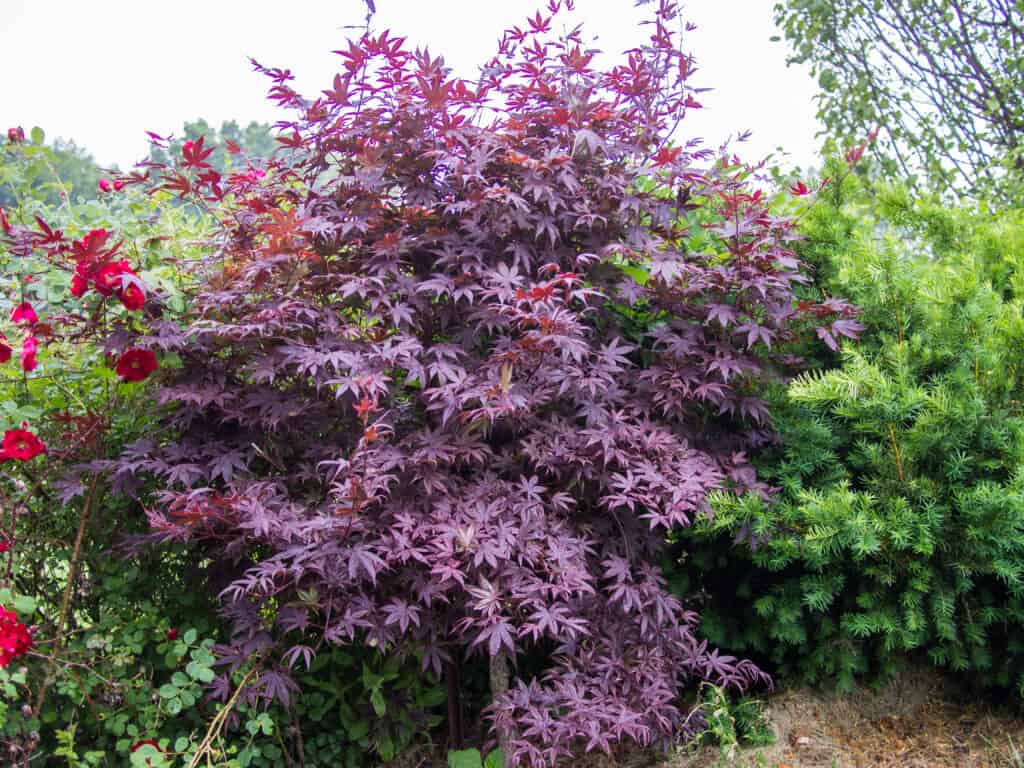
Acer palmatum ‘Bloodgood’ features deep reddish-purple summer foliage
©F. D. Richards / Flickr – License
Bloodgood Japanese Maple vs. Emperor Japanese Maple: Special Features
The Bloodgood Japanese maple’s capacity to maintain its color throughout the season is one of its most alluring qualities. In the spring and into the summer, a rich burgundy color occurs. Autumn’s cool months saw a vibrant red take over.
The Emperor Japanese maple tree stands up to its reputation as the leader in vibrant hues and simple, effortless development, from its stunning ruby red color to its sturdy resilience. One of the most resilient types of Japanese maple is the Emperor, which is renowned for its toughness and rapid growth. And unlike other types, the Emperor keeps its stunning color throughout the entire growing season.
If you need a tree that is more tolerant to heat and cold, opt for an Emperor Japanese maple. If you’re more interested in a larger tree, the classic Bloodgood is a perfect choice. Regardless of what you prefer, it’s worth noting that both of these varieties of Japanese maple suit most landscapes and can easily be grown together.
What Other Maple Trees Produce Stunning Fall Colors?
Maple trees are known for producing vibrant shades of burgundy, red, orange, and gold in the fall that captivate the hearts of folks who appreciate the rustic beauty of autumn. Below is a list of some stunning varieties of maples that will produce glorious autumnal foliage.
Sugar Maple (Acer saccharum)
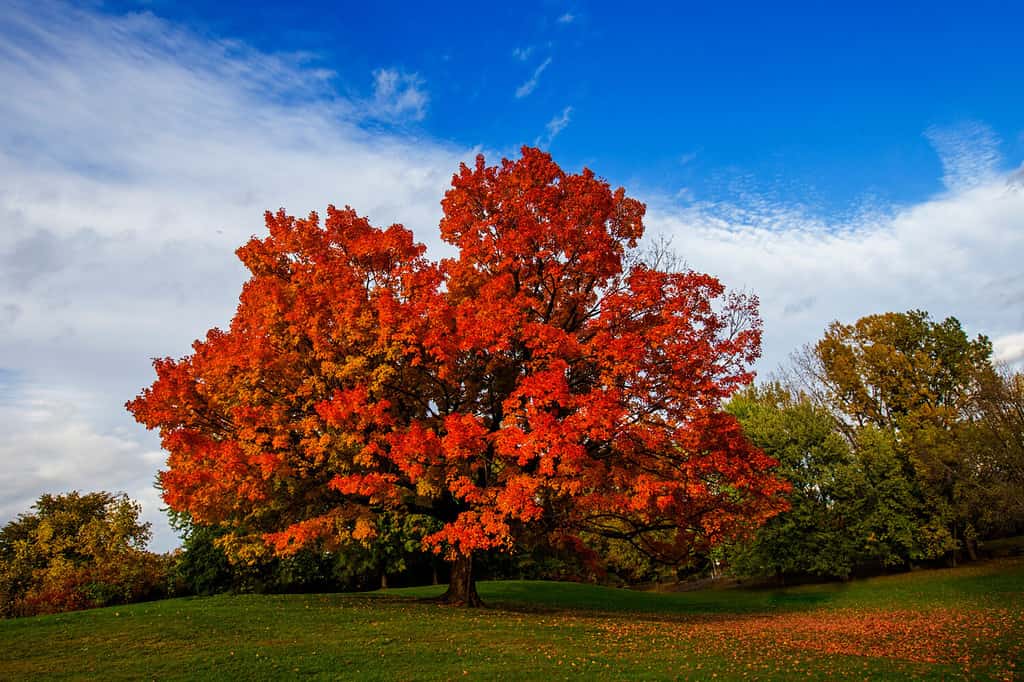
Sugar maples not only produce gorgeous colors in the fall–they also produce maple syrup.
©Mircea Costina/Shutterstock.com
The leaves on this tree turn deep shades of yellow, orange, and red, and the trees can grow upwards of 40-80 feet while spreading out as much as 60 feet. Sugar maples are famous for their ability to produce maple syrup, a breakfast staple for pancakes and waffles in the United States. They thrive in the eastern areas of North America in growing zones 3 to 8.
Amur Maple (Acer tataricum subsp. ginnala ‘Flame’)
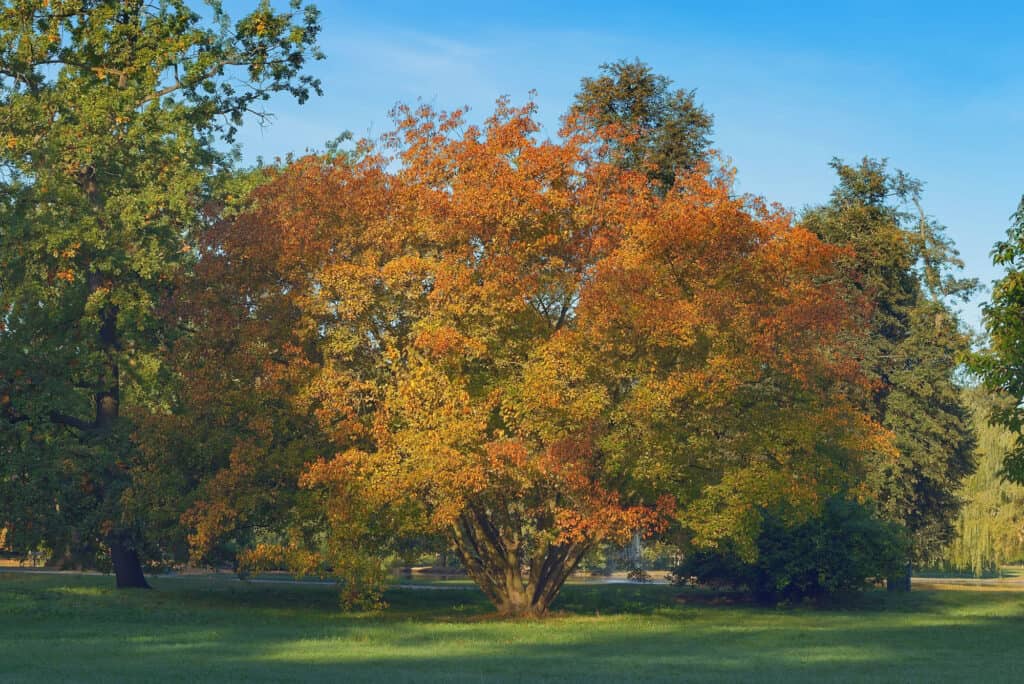
If you are looking for a fairly small landscaping tree, the amur maple may be a good choice.
©arazu/Shutterstock.com
These trees are native to southeastern Europe and western Asia, popular in urban areas because of their compactness. The fall foliage for these modest maples is a brilliant red, sometimes yellow. They can grow in USDA growing zones 2-8, and tend to reach heights of 15-20 feet.
Paperbark Maple (Acer griseum)
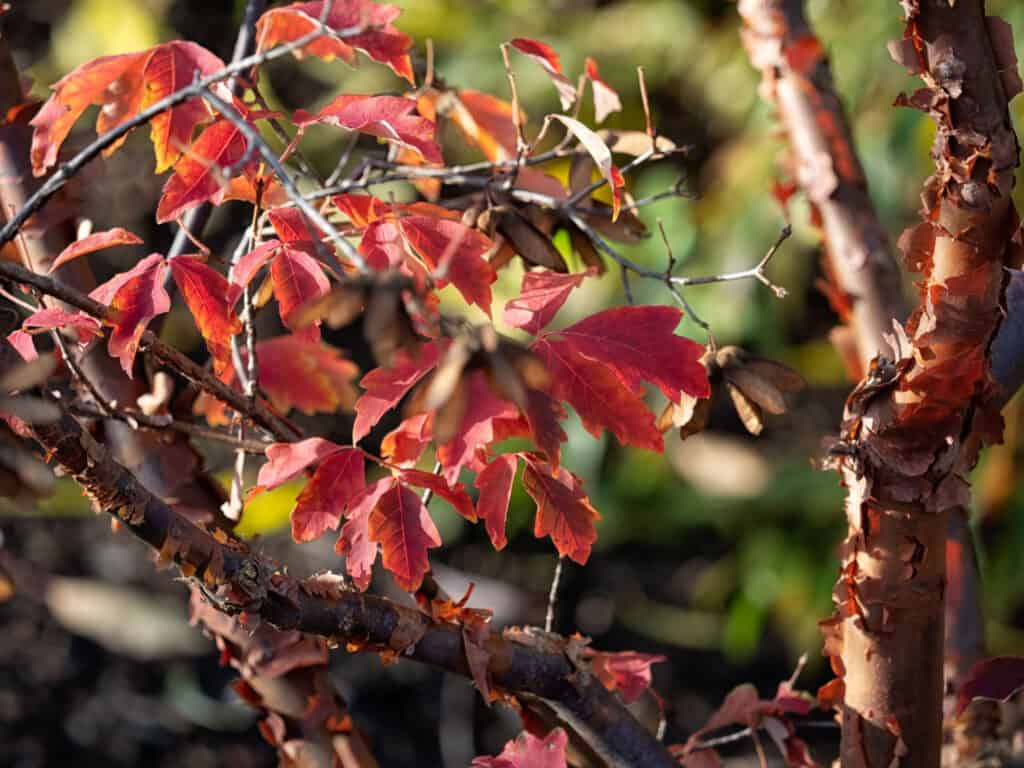
Small and striking, paperbark maples make a great ornamental addition to any landscaping project.
©Chris Lawrence Travel/Shutterstock.com
If you’re looking for a maple with an interesting trunk, try the paperbark maple, whose bark has a peeling appearance similar to a birch tree. Though they originate in central and eastern China, these trees can grow well in USDA Growing Zones 4-8, capable of reaching heights of 20-30 feet. Their fall colors are typically red, though they can also be reddish-green or orange.
The photo featured at the top of this post is © Robert Felcan/Shutterstock.com
Sources
- PlantingTree.com, Available here: https://www.plantingtree.com/products/bloodgood-japanese-maple
- PlantingTree.com, Available here: https://www.plantingtree.com/products/emperor-japanese-maple
- NC State Extension, Available here: https://plants.ces.ncsu.edu/plants/acer-palmatum
FAQs (Frequently Asked Questions)
Is there a difference between the Bloodgood Japanese maple and the Emperor Japanese maple?
The Bloodgood variety of Japanese maple can easily reach 25 feet in height as well as width, while the smaller Emperor variety only reaches about 20 feet in height and width.
Can Japanese maples tolerate full sun?
Most Japanese maples do not tolerate full sun well, though the bloodgood variety does well in full sun as long as they receive adequate water.
Are Bloodgood Japanese maples more common than Emperor Japanese maples?
The Bloodgood Japanese maple is more widely available in the United States than the Emperor variety.
Thank you for reading! Have some feedback for us? Contact the AZ Animals editorial team.






